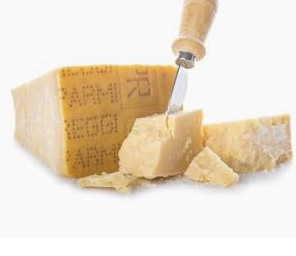This is a comprehensive guide to help you identify high-quality Parmigiano-Reggiano:

by A. Geri
1. Labeling and Origin
- Protected Designation of Origin (PDO): Genuine Parmigiano-Reggiano is marked with the PDO seal, indicating it was produced in the designated areas of Italy (Emilia-Romagna and Lombardy regions).
- Consorzio Markings: Look for the distinctive marks and stamps of the Consorzio del Formaggio Parmigiano-Reggiano, the regulatory body. This includes the dotted writing on the rind and the casein plate.
2. Appearance
- Rind: The rind should be hard and thick with a golden-yellow color. The Parmigiano-Reggiano name should be stamped repeatedly on the rind.
- Color: The interior should be a uniform pale yellow or straw color. It should not have any white patches or be overly pale.
3. Texture
- Crystalline Structure: Good Parmigiano-Reggiano has a slightly gritty texture due to the presence of amino acid crystals (tyrosine) that form during the aging process.
- Grainy and Flaky: The cheese should be granular and break off into flakes rather than crumbling easily.
4. Aroma
- Complex and Rich: High-quality Parmigiano-Reggiano has a strong, nutty, and fruity aroma. It should smell fragrant, with hints of pineapple or tropical fruits.
5. Flavor
- Balanced and Intense: The flavor should be rich and savory, with a balance of sweet, salty, and umami. The taste should linger on the palate with a slight nuttiness.
- Aging: Parmigiano-Reggiano is aged for a minimum of 12 months, but high-quality versions are often aged for 24, 36, or even 48 months. The flavor becomes more complex and pronounced with age.
6. Packaging and Purchase
- Whole Pieces vs. Pre-Grated: It’s best to buy whole pieces with the rind intact. Pre-grated cheese can lose flavor and is often mixed with anti-caking agents.
- Reputable Sellers: Purchase from reputable cheese shops or sellers who can provide information about the cheese’s origin and age.
7. Storage and Handling
- Proper Storage: Keep the cheese wrapped in wax paper or parchment paper inside an airtight container in the refrigerator. This preserves its moisture and prevents it from drying out.
Additional Tips:
- Taste Test: If possible, taste the cheese before purchasing. A good seller should offer samples.
- Look for Crystals: The presence of small white crystals (tyrosine) is a good sign of well-aged Parmigiano-Reggiano.
By following these guidelines, you can ensure that you select high-quality Parmigiano-Reggiano cheese that offers the best flavor and texture for your culinary needs. You might also be interested to try these five recipes with Parmigano. They are including some vegan product alternatives.
Here is my recipe for a classic carbonara pasta for you to enjoy:
Ingredients:
- 400g spaghetti or pasta of your choice. I have for you a list of 3 kinds of pasta to recomend: gluten free italian pasta, wholeweat organic pasta, and organic spagetti Italian dried pasta
- 200g pancetta or guanciale, diced
- 2 large eggs
- 100g Pecorino Romano cheese, finely grated
- 50g Parmesan cheese, finely grated (optional)
- 2 cloves garlic, peeled and whole (optional)
- Salt, to taste
- Freshly ground black pepper, to taste
- good quality extra virgin olive oil. I highly recommmend the Amazon bestseller November Polyphenols organic olive oil – Early harvest – Fresh harvest – Bio – Premium extra virgin – Cold extracted – High Phenolic EVOO – Greek – 500 ml.
Instructions:
- Cook the Pasta:
- Bring a large pot of salted water to a boil. Add the spaghetti and cook until al dente, according to package instructions.
- Reserve about 1 cup of pasta water, then drain the spaghetti.
- Prepare the Pancetta/Guanciale:
- While the pasta is cooking, heat a large skillet over medium heat. Add the diced pancetta or guanciale.
- (Optional) Add the whole garlic cloves to the skillet to infuse flavor, then remove and discard them once the pancetta/guanciale is crisp.
- Cook until the pancetta/guanciale is crispy and browned, about 5-7 minutes. Remove the skillet from the heat.
- Prepare the Egg Mixture:
- In a medium bowl, whisk together the eggs and grated Pecorino Romano cheese (and Parmesan cheese, if using). Season with a generous amount of freshly ground black pepper.
- Combine and Serve:
- Quickly add the hot, drained spaghetti to the skillet with the pancetta/guanciale and toss to coat.
- Remove the skillet from the heat and quickly pour the egg and cheese mixture over the pasta, tossing continuously to create a creamy sauce. Add a bit of the reserved pasta water if the sauce needs thinning.
- Taste and adjust seasoning with salt and pepper if necessary.
- Serve Immediately:
- Serve the Carbonara immediately, garnished with extra grated Pecorino Romano and freshly ground black pepper.
Enjoy your classic Carbonara pasta!
